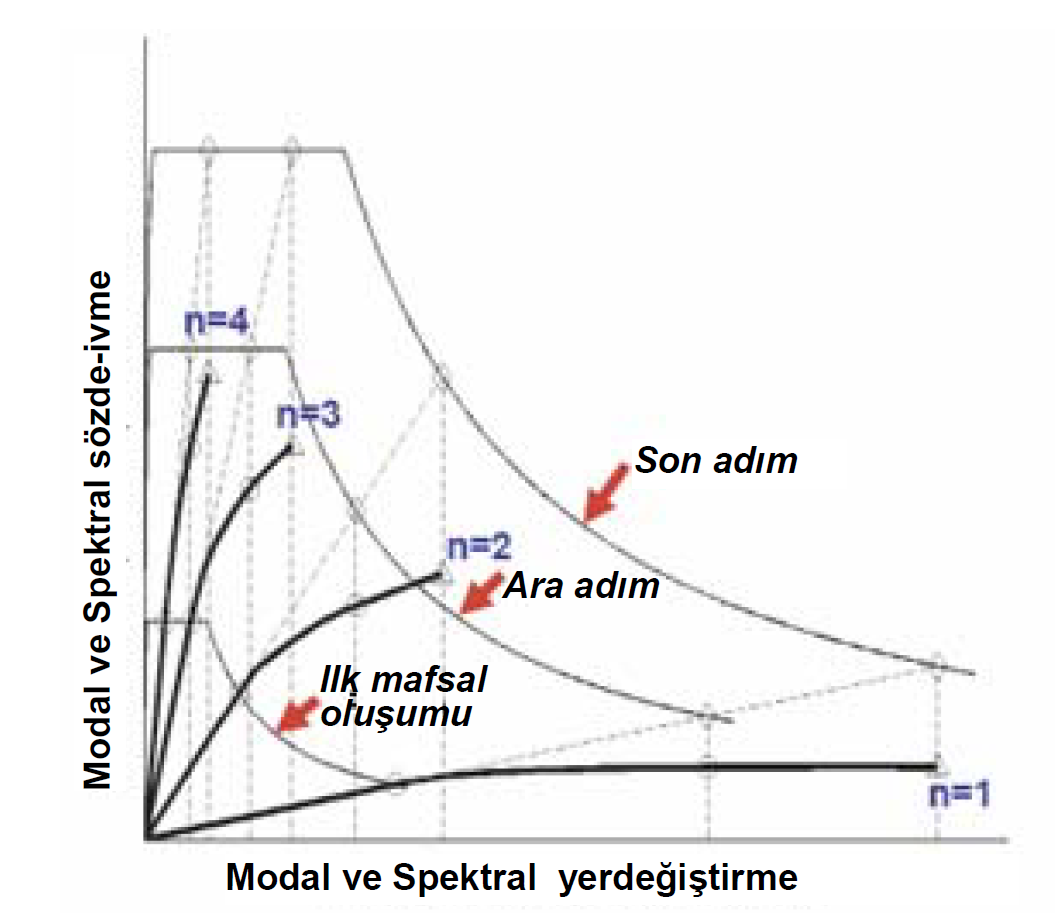Incremental Response Spectrum Analysis (IRSA Method)
One of the two main approaches for the design of building bearing systems under the effect of earthquakes is the Assessment and Design Based on Shape Change (ŞGDT) approach. TBDY Article 5.1.1The principles of the ŞGDT approach are defined in. Internal force-deformation relations compatible with nonlinear modeling approaches of the existing or previously pre-designed structural system element are determined. Under the earthquake ground motion selected in accordance with the anticipated performance target, the structural system is calculated by static or dynamic incremental methods, deformation demands for nonlinear ductile behavior and strength demands for brittle behavior are obtained. The obtained deformation and internal force demands are compared with the deformation and strength capacities defined in accordance with the anticipated performance target.
TBDY section 5.6 'in Methods in Nonlinear push 5.6.2, 5.6.3 and 5.6.4 ' in Single Mode push Methods and 5.6.6 at Multimodal push methods are described. The Incremental Spectrum Analysis (ARSA) Method is a multi-modal pushover analysis method recommended for the Evaluation and Design of Buildings and Bridges under the effects of earthquakes . In the thrust analysis made with the ARSA method, the horizontal elastic design spectrum defined in TBDY Article 2.3.4 is used . TBDY Part Appendix 4B.2 at each linear pushing stepThe modal combination method described in. is used, and modal displacement increments are scaled using the "equal displacement rule" .
Multimodal pushover analysis method Incremental Spectrum Analysis (ARSA) is an "adaptive" method that takes into account mode shapes compatible with plastic hinges formed in each thrust step and is a general analysis method independent of the structure type. ARSA is a displacement controlled pushover analysis method based on linear spectrum analysis. In other words, the value of the displacement to be made in each step of each mode of the system with certain dynamic characteristics is read from the spectrum. Then, the internal forces that occur are found separately and the results (displacements, moments, etc.) are combined at the end of the step.
The most critical point in the ARSA method is the scaling of the modal displacement increments, Δd n (i) , at each repulsion step in order to determine the relative values of the modal sizes .

In this relation (n) is the number of modes, shows the incremental scale coefficient which is constant for all modes in step (i). It is the elastic spectral displacement of the nth mode in the first repulsion step (linear elastic case) from S (1) . Detailed explanation of the method will be made. Here, modal scaling is done for each mode and the basis of this scaling is "equal displacement rule". In this rule, it is assumed that nonlinear spectral displacement is equal to elastic spectral displacement. The figure below shows a representative graph of the Modal and Spectral substitutions for each mode scaling at each impulse step of the spectral pseudo-acceleration plots derived from the horizontal elastic design spectrum.
:art_ölç_kat:

Since ARSA applies the equal displacement rule, the building performance point is determined at the beginning of the analysis, so there is no need for additional operations. This is one of the important advantages of the ARSA method.
In the TBDY Article 5.6.6.1 , all internal forces and displacements obtained as a result of applying the "Multimode Thrust Method for linear calculation using the initial (elastic) stiffnesses in the special case according to the given design spectrum, are to 4.8.2 on the basis of the same design spectrum . it will be shown in the account report that it is exactly the same with the sizes obtained. An expression in the form of. Since the analysis criteria of the earthquake calculation with the mode combination method specified in 4.8.2 in the ARSA method are applied in each step, this condition is automatically met when the ARSA method is used as the Multimodal Push Method .
In case independent fixed modal load vectors defined for different vibration modes of the building are applied incrementally to the structure separately in the "Multimodal Thrust Method Used in TBDY Article 5.6.6.2 , the resulting modal internal forces will not be statistically combined, combined according to 4B.2.4 . modal element will be calculated in accordance with tip displacements and yield rotations. " An expression in the form of. The ARSA method is applied to the structure incrementally with the modal analysis performed in each pushing step, and the unit deformation and internal force values are obtained at the end of each step. At the end of each step, the Full Quadratic Combination (TKB or CQC) Rule described in TBDY Section Annex 4B.2.4 is applied.
The stages of the Incremental Spectrum Analysis (ARSA) method, which is one of the Multimodal Propulsion Methods , can be summarized as follows. Detailed explanation of each stage is explained within the headings.
Determination of the Performance Point for Each Vibration Mode and Direction
Determination of Modal Pseudo-Acceleration, Modal Displacement Increment and Constant Scale Factor
Determination of Internal Forces for Each Direction and Mode
Determination of Yielded Hinges and Modified Stiffness Matrix
Related Topics
